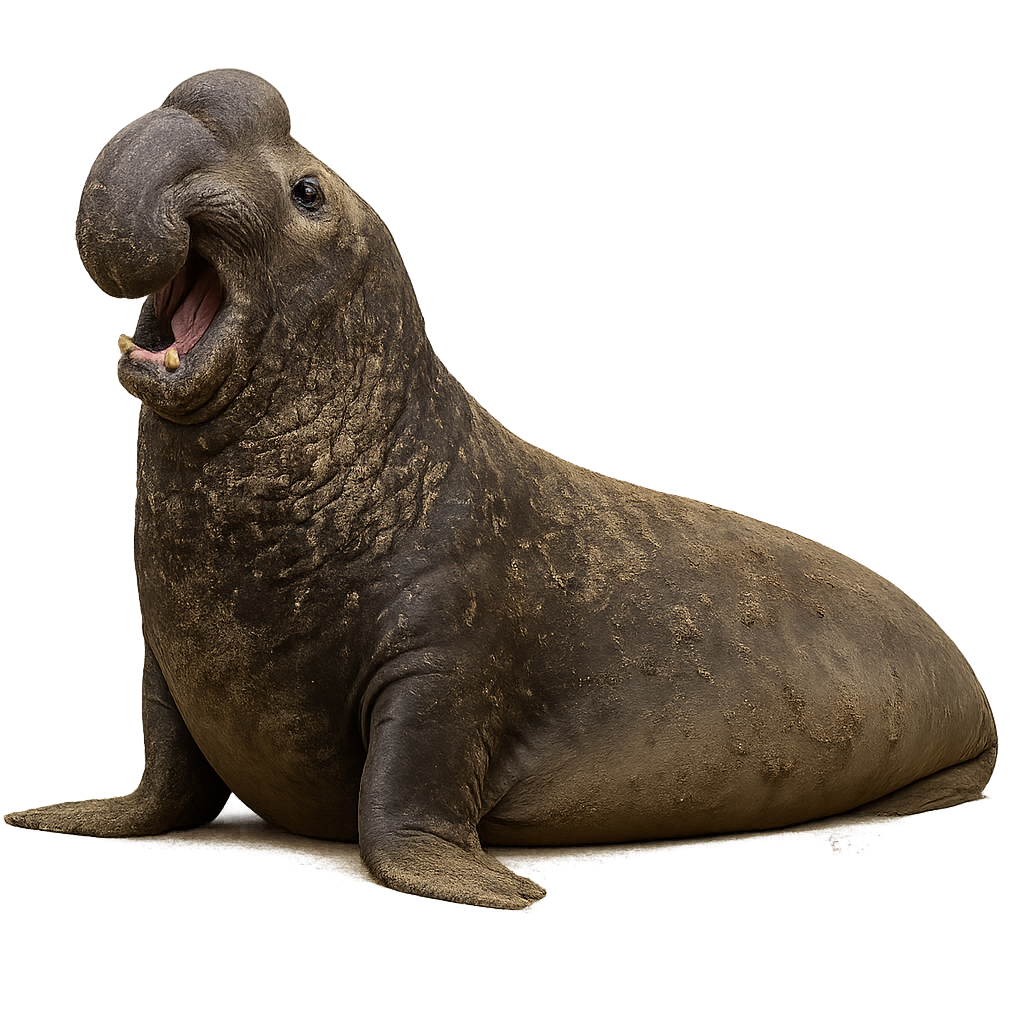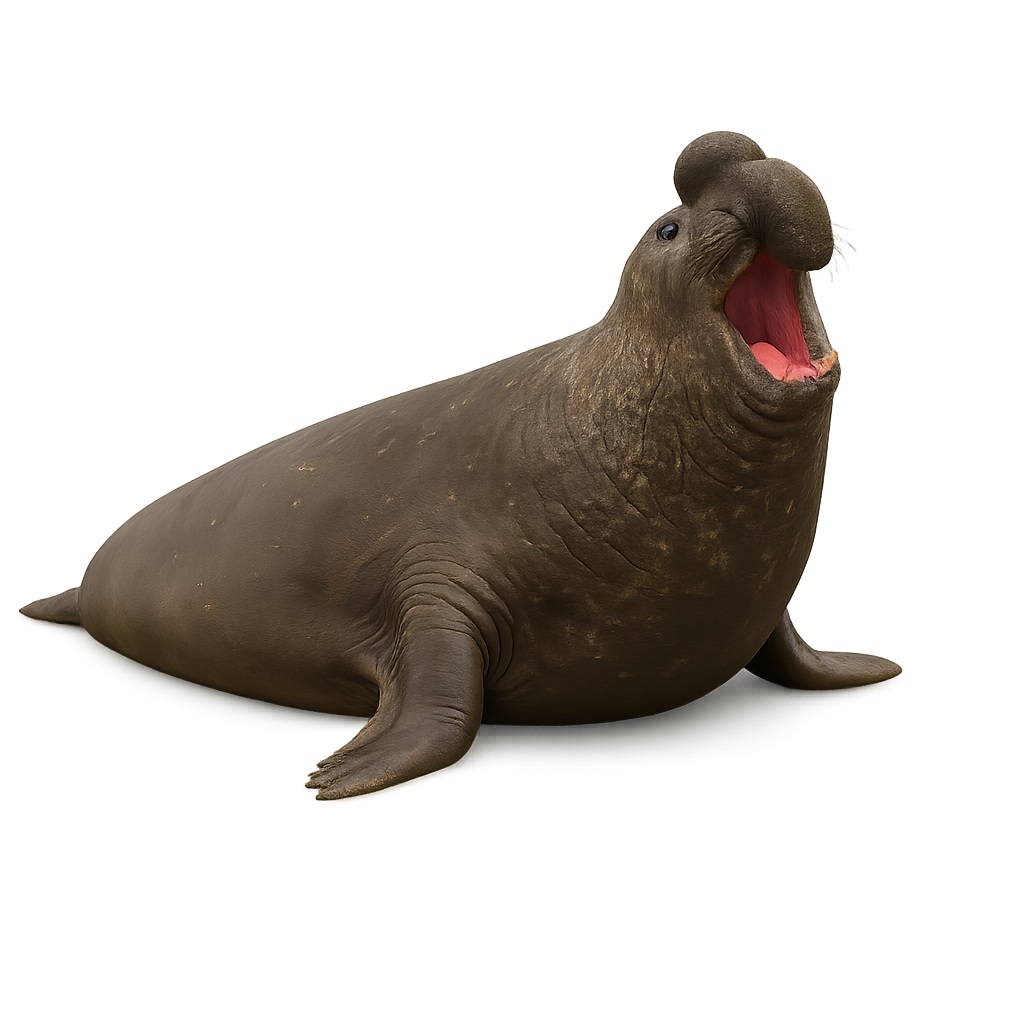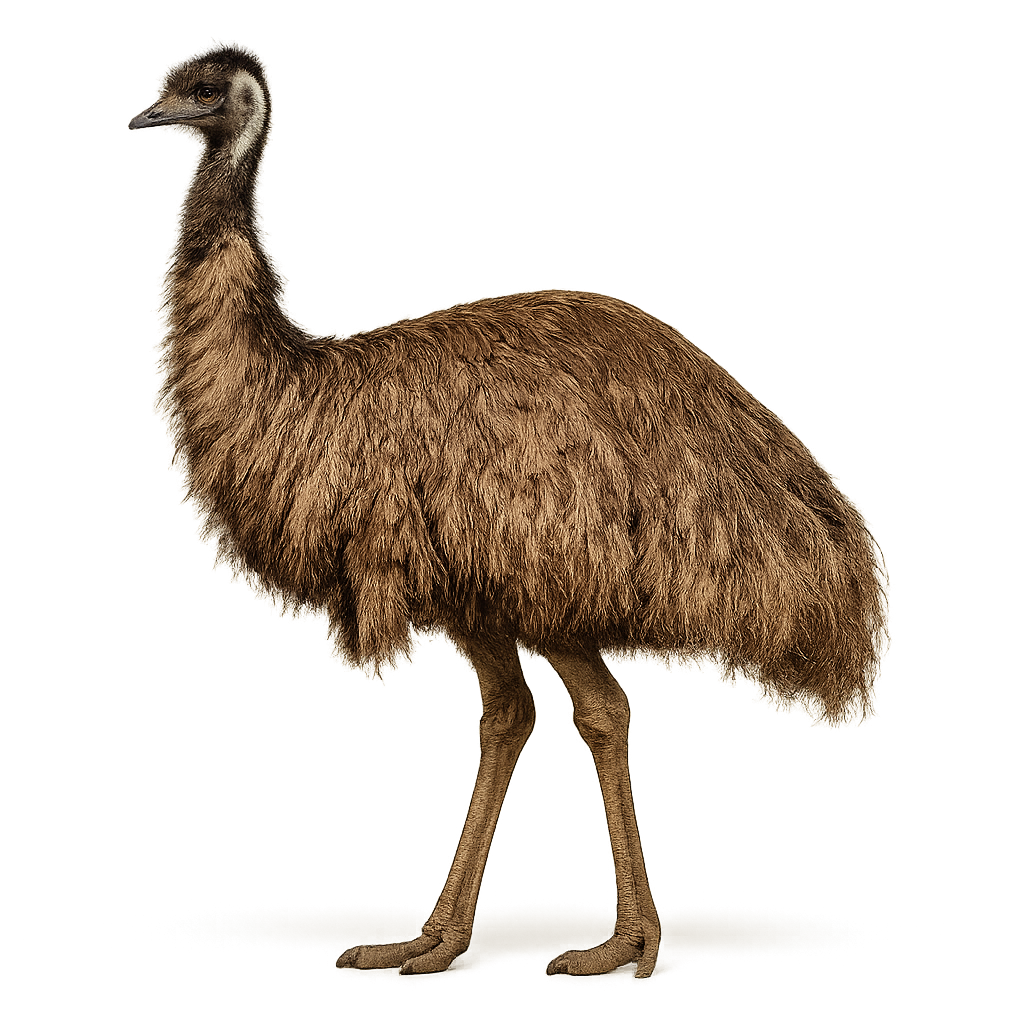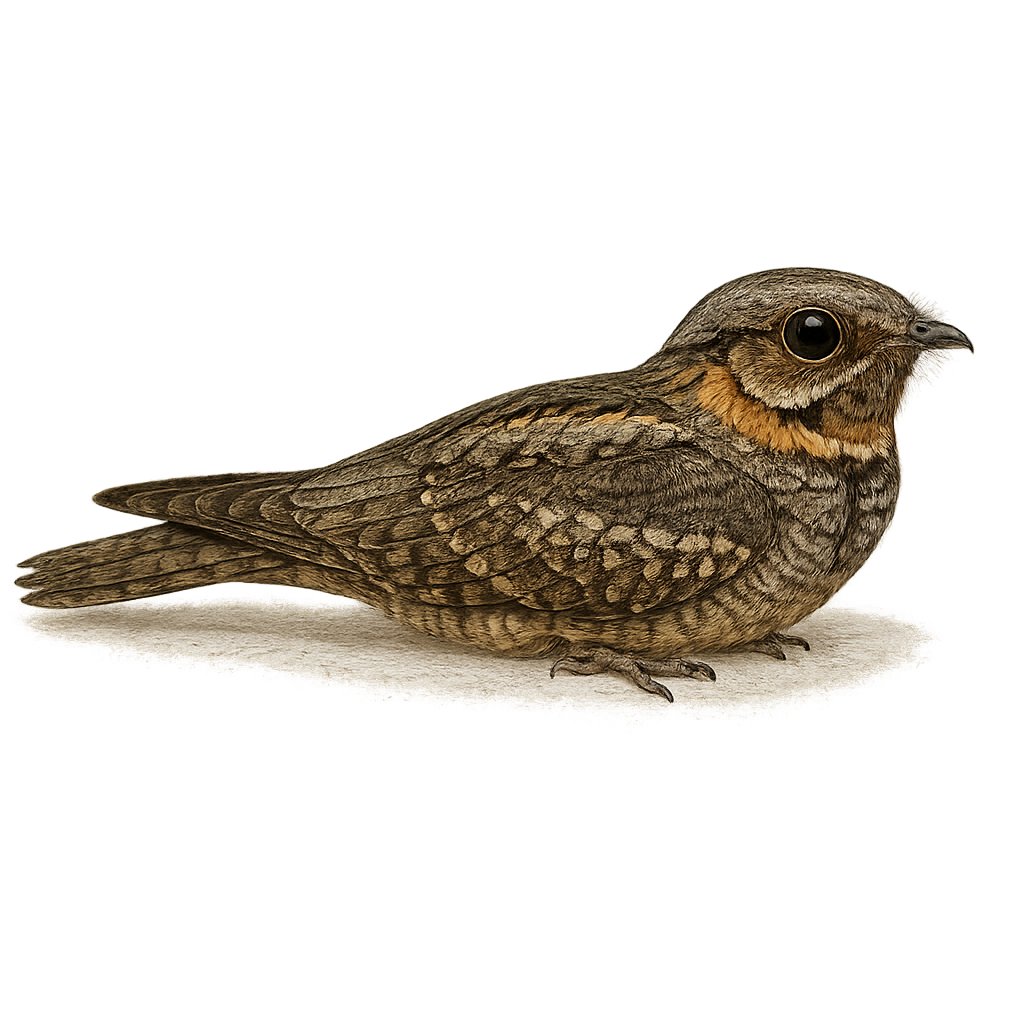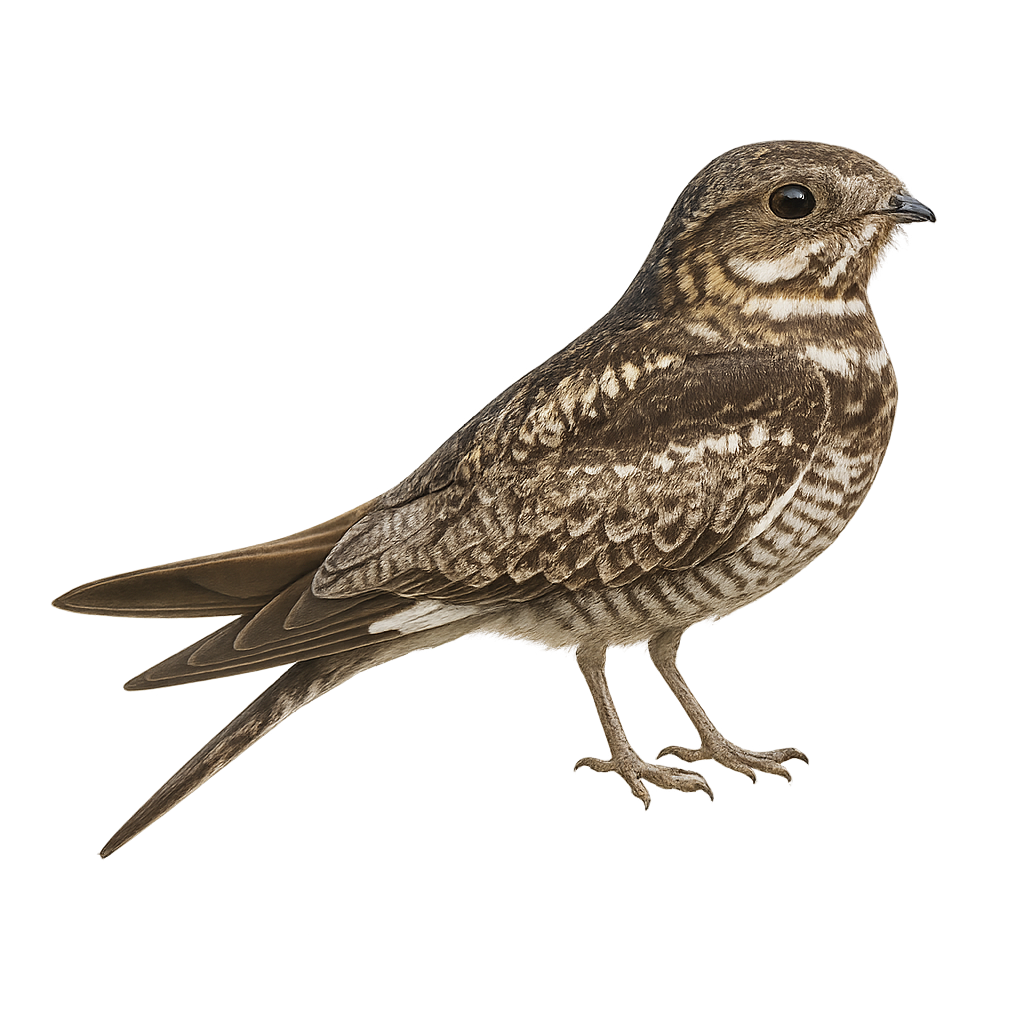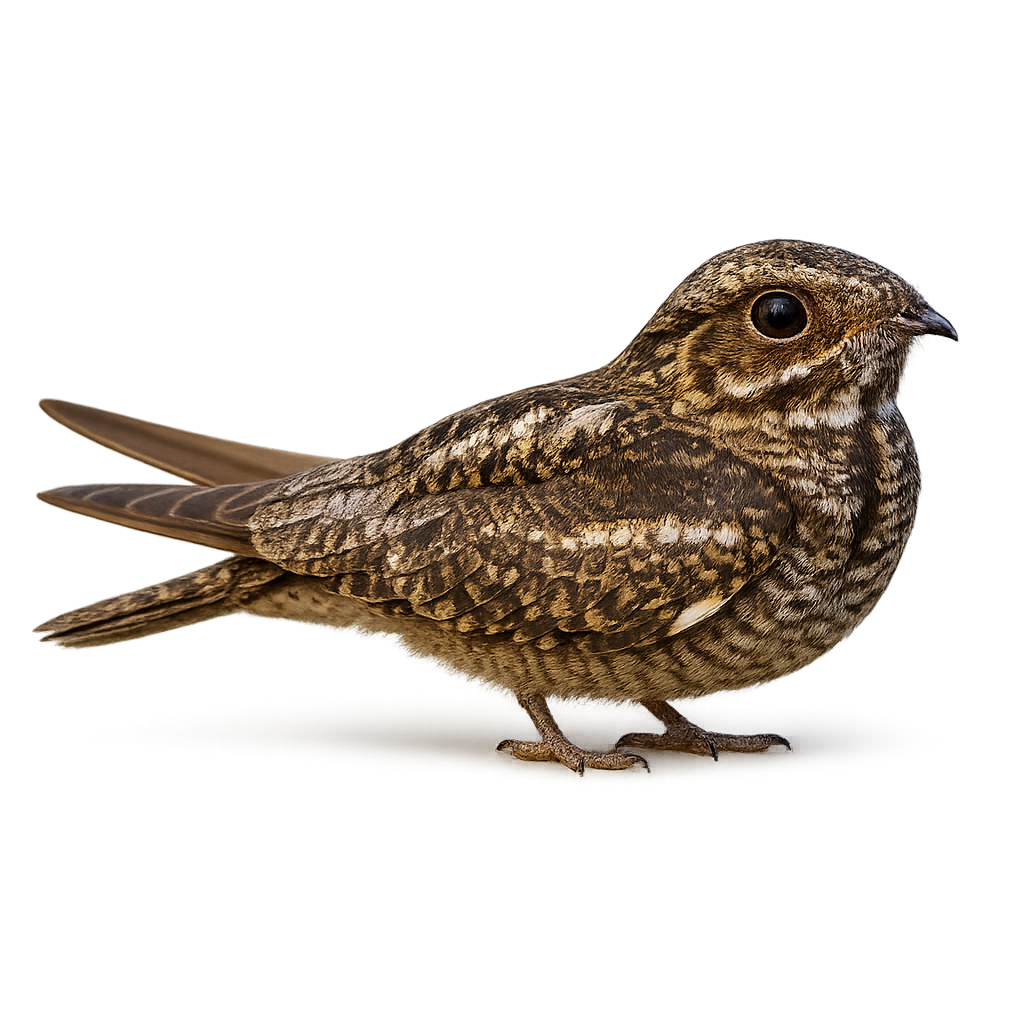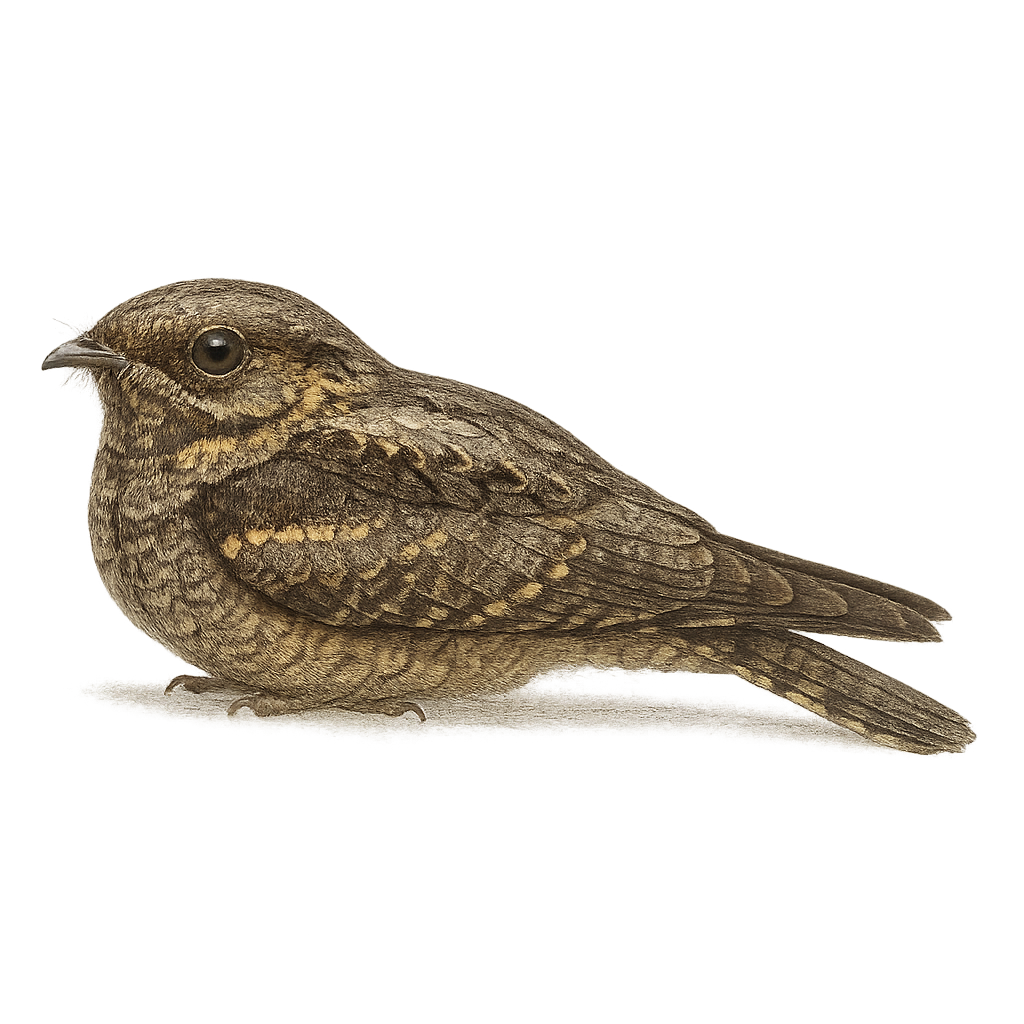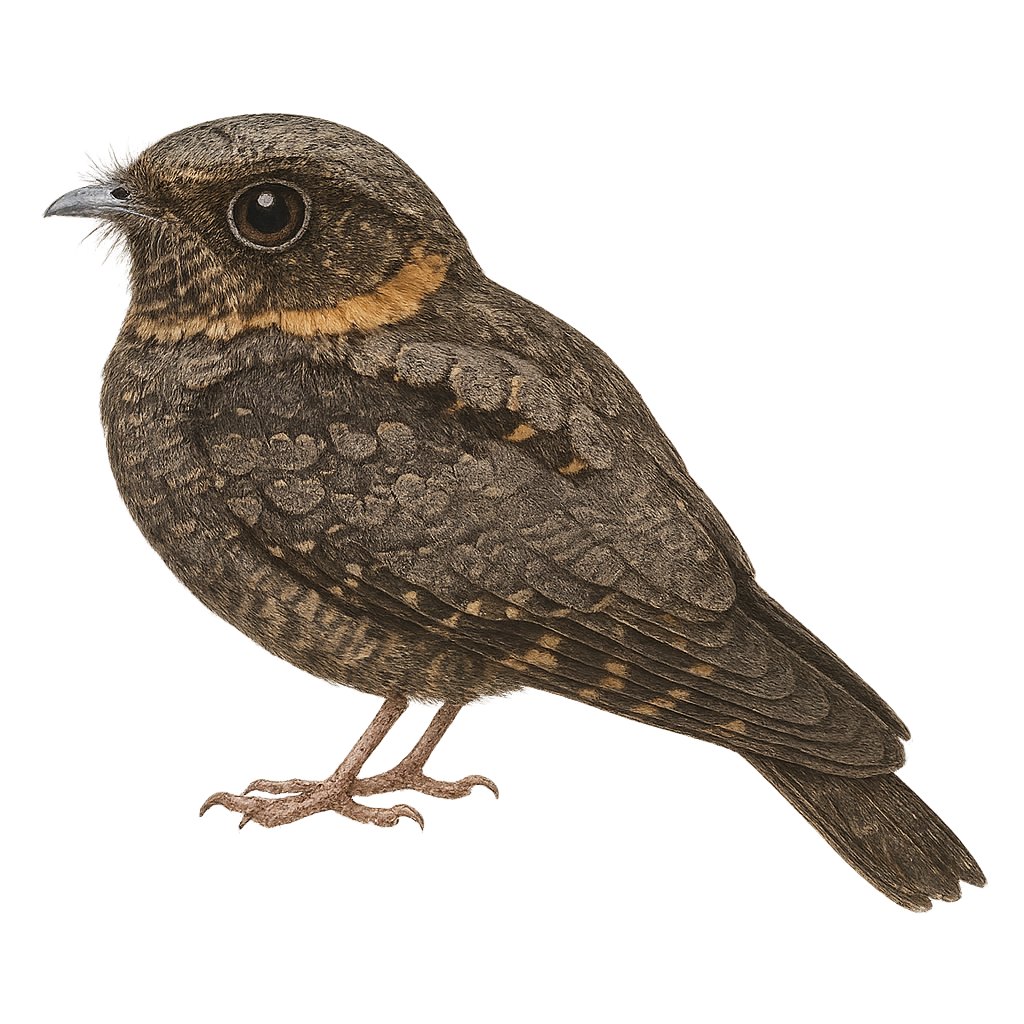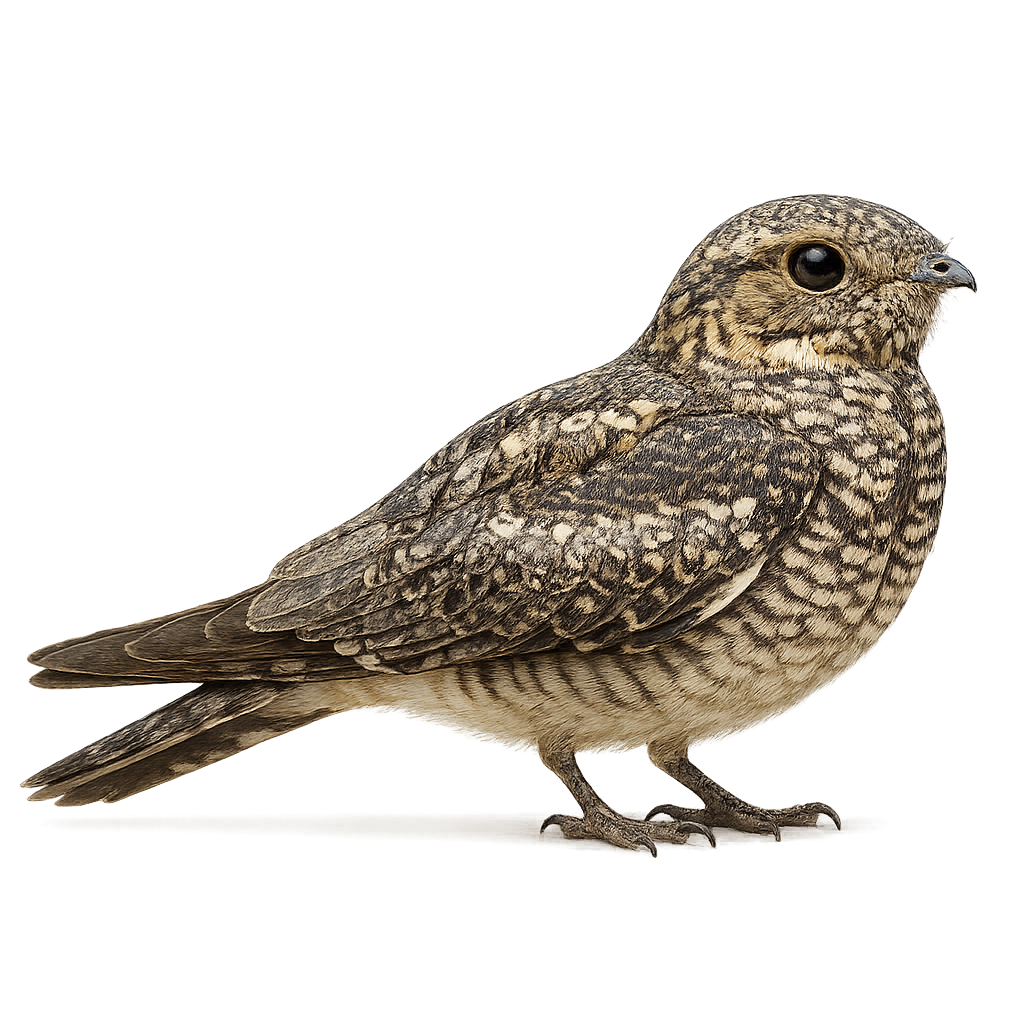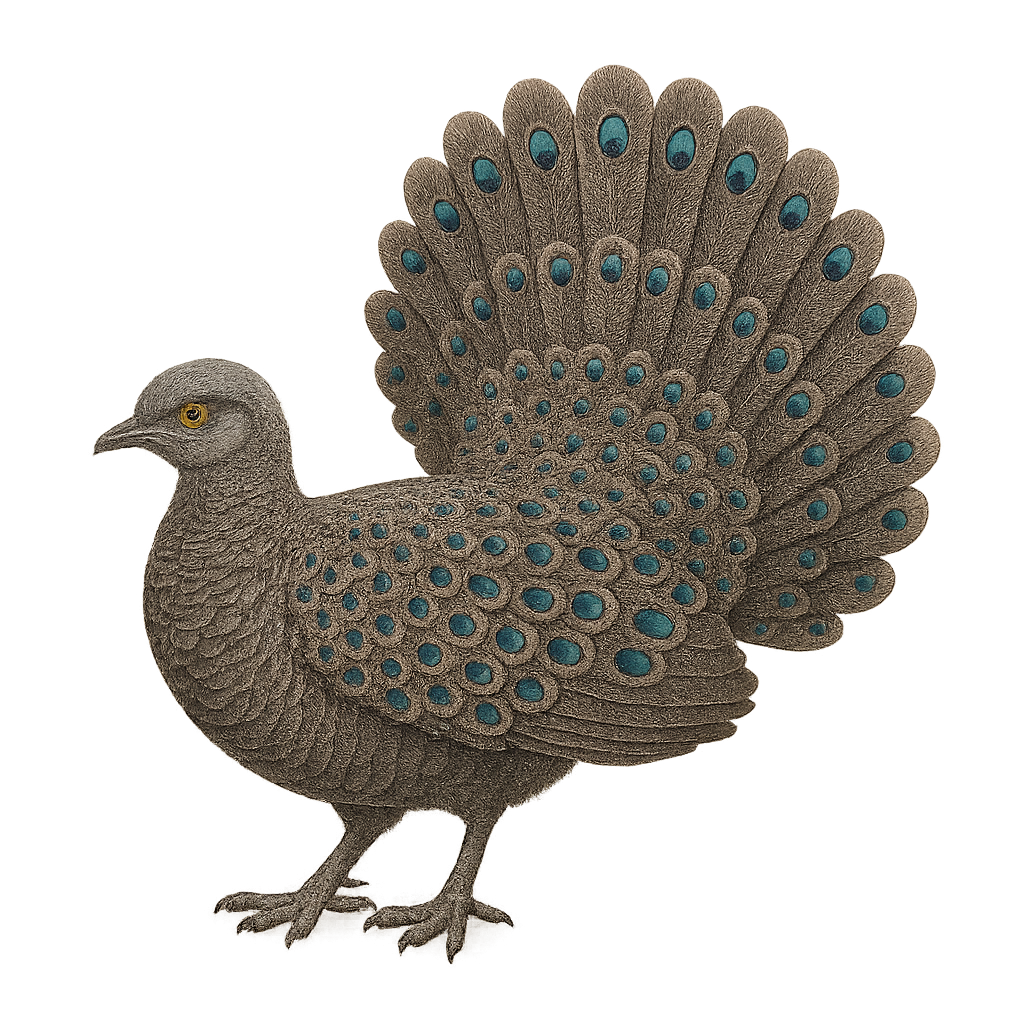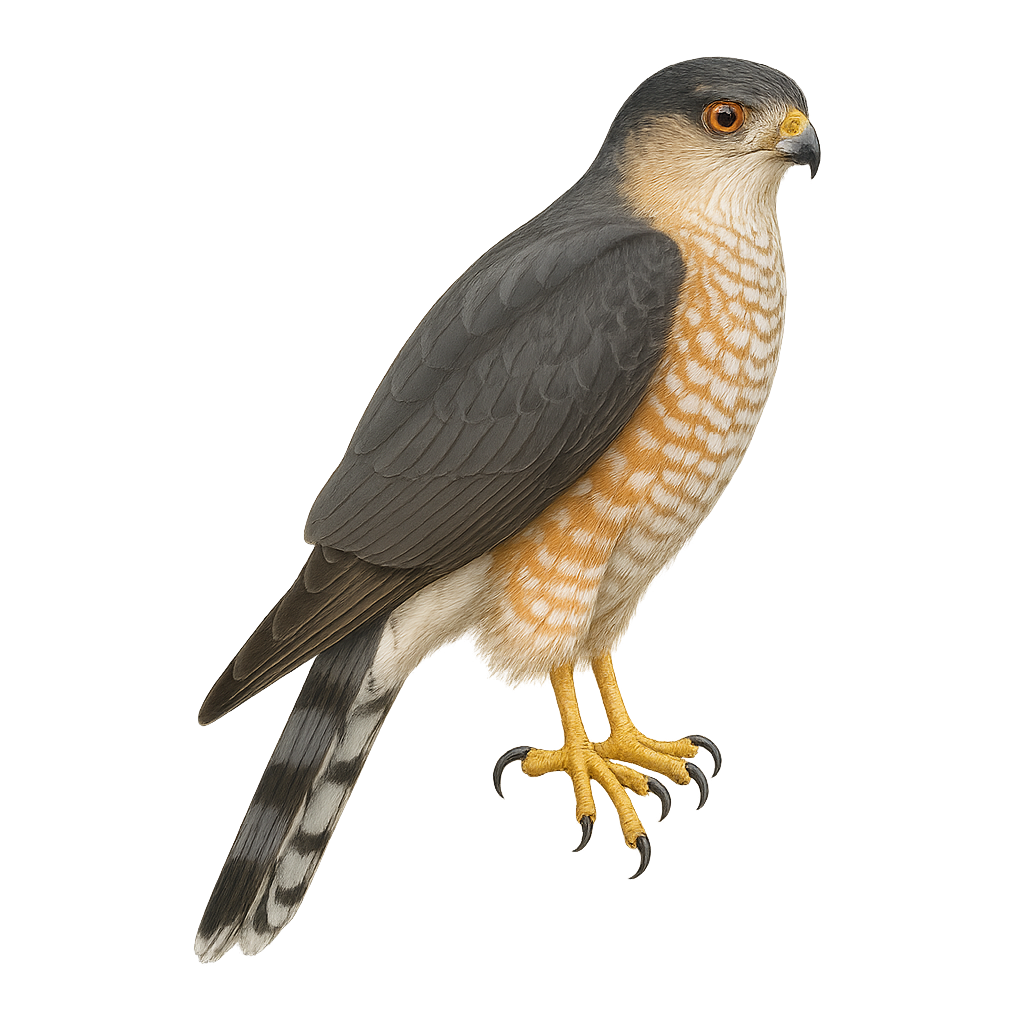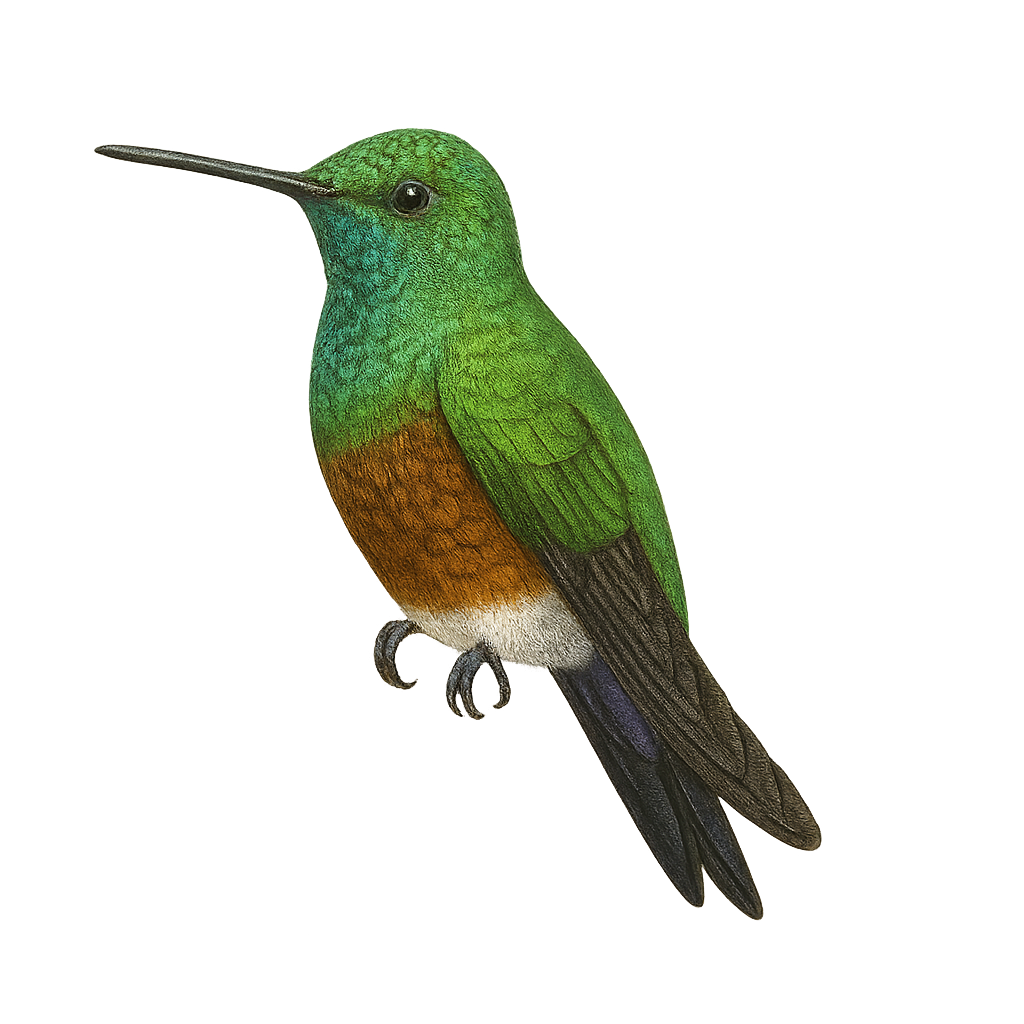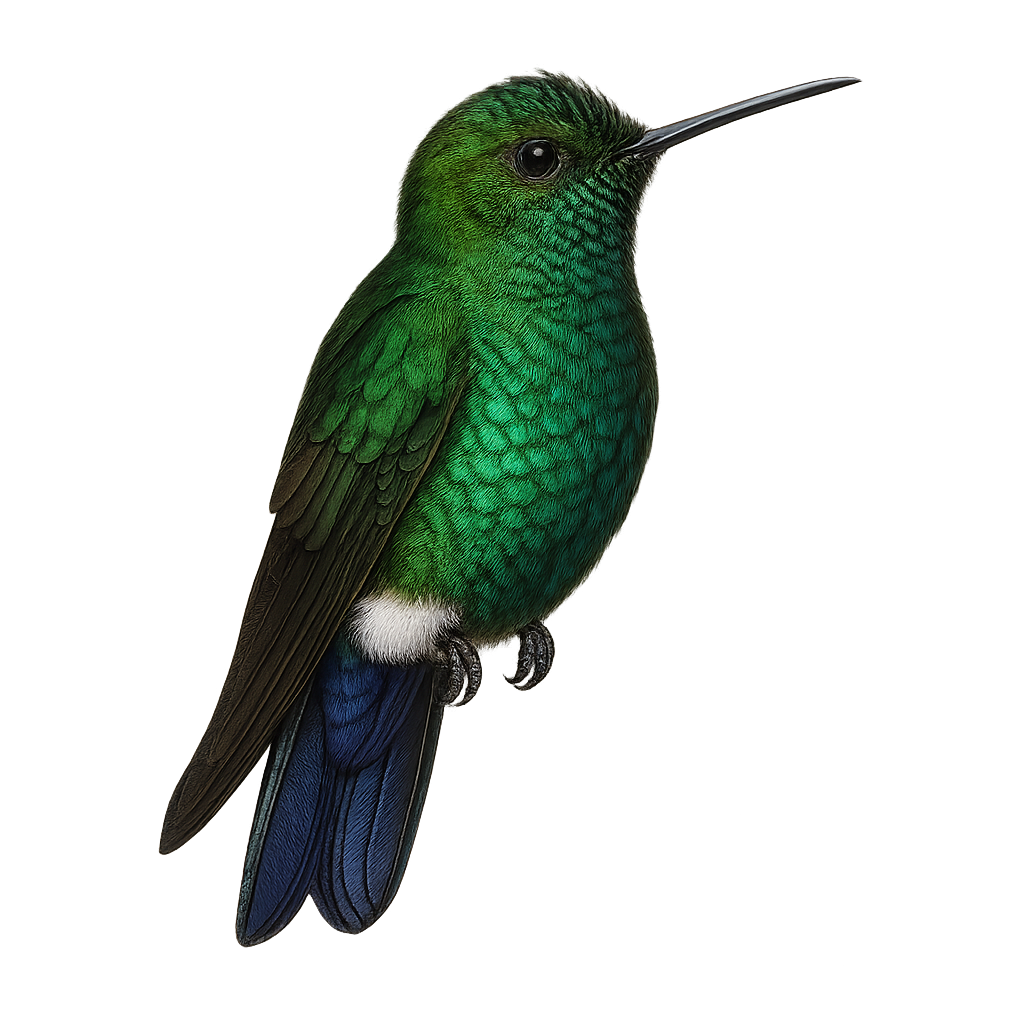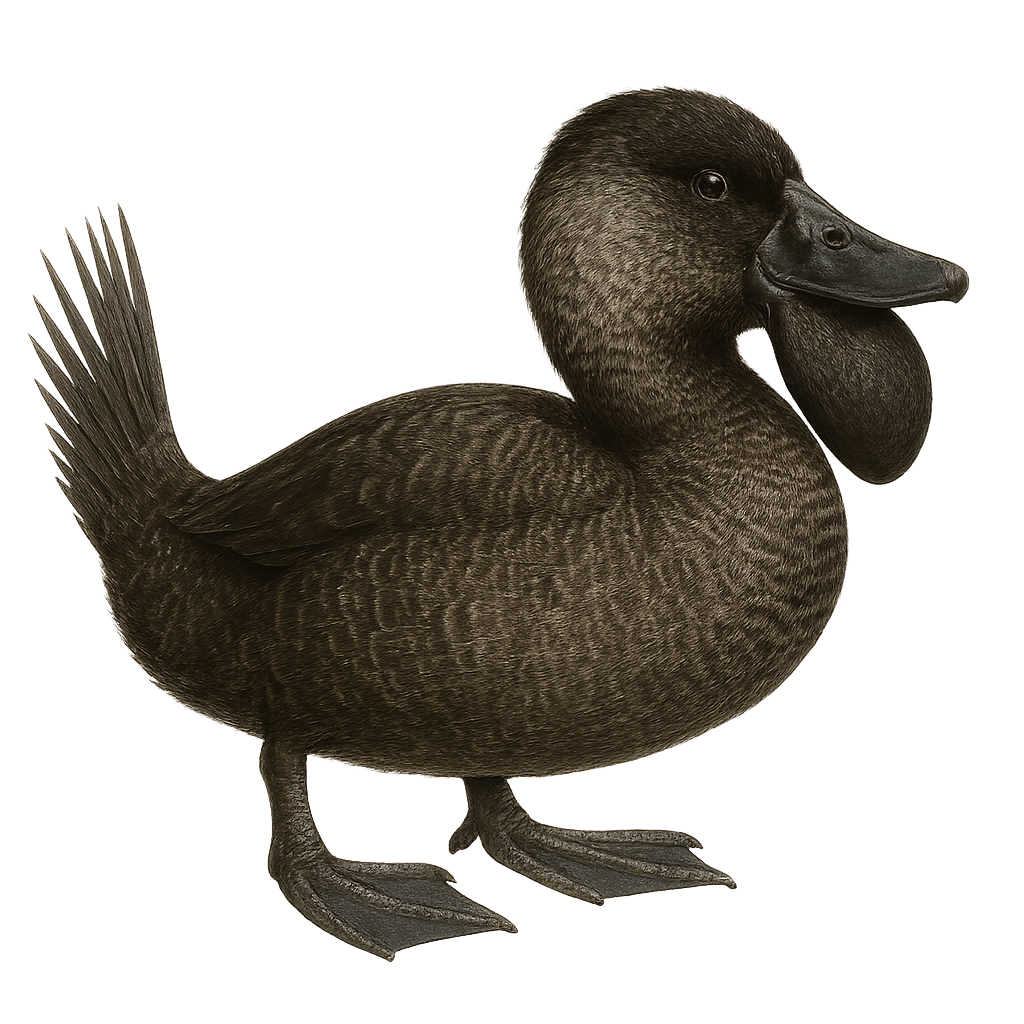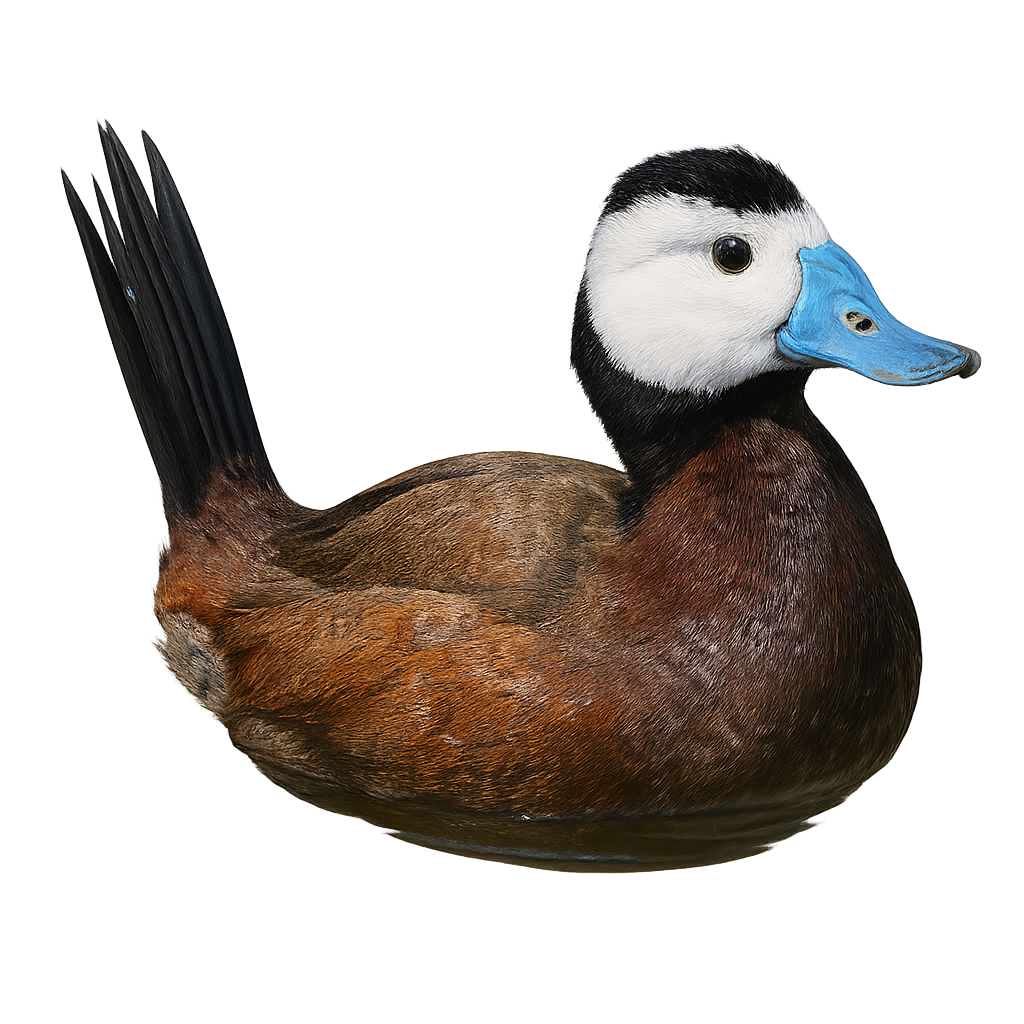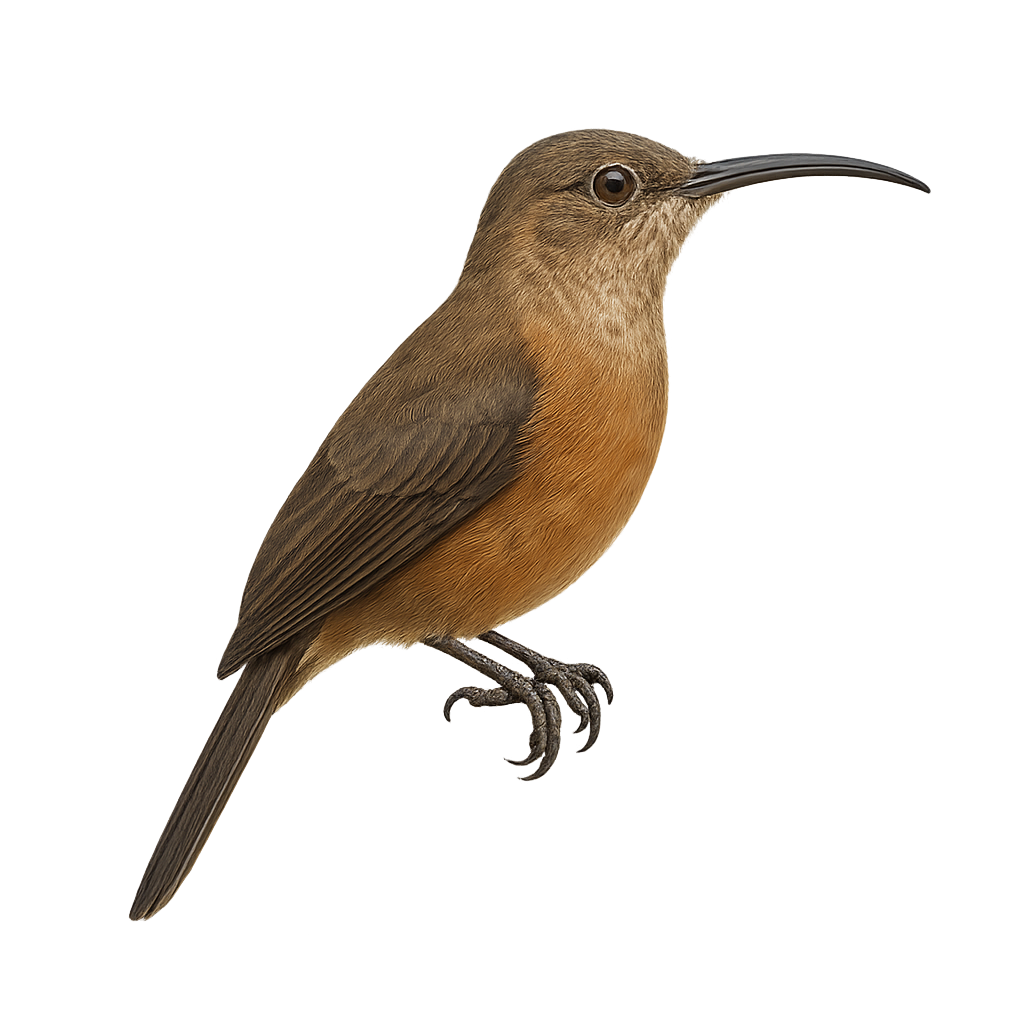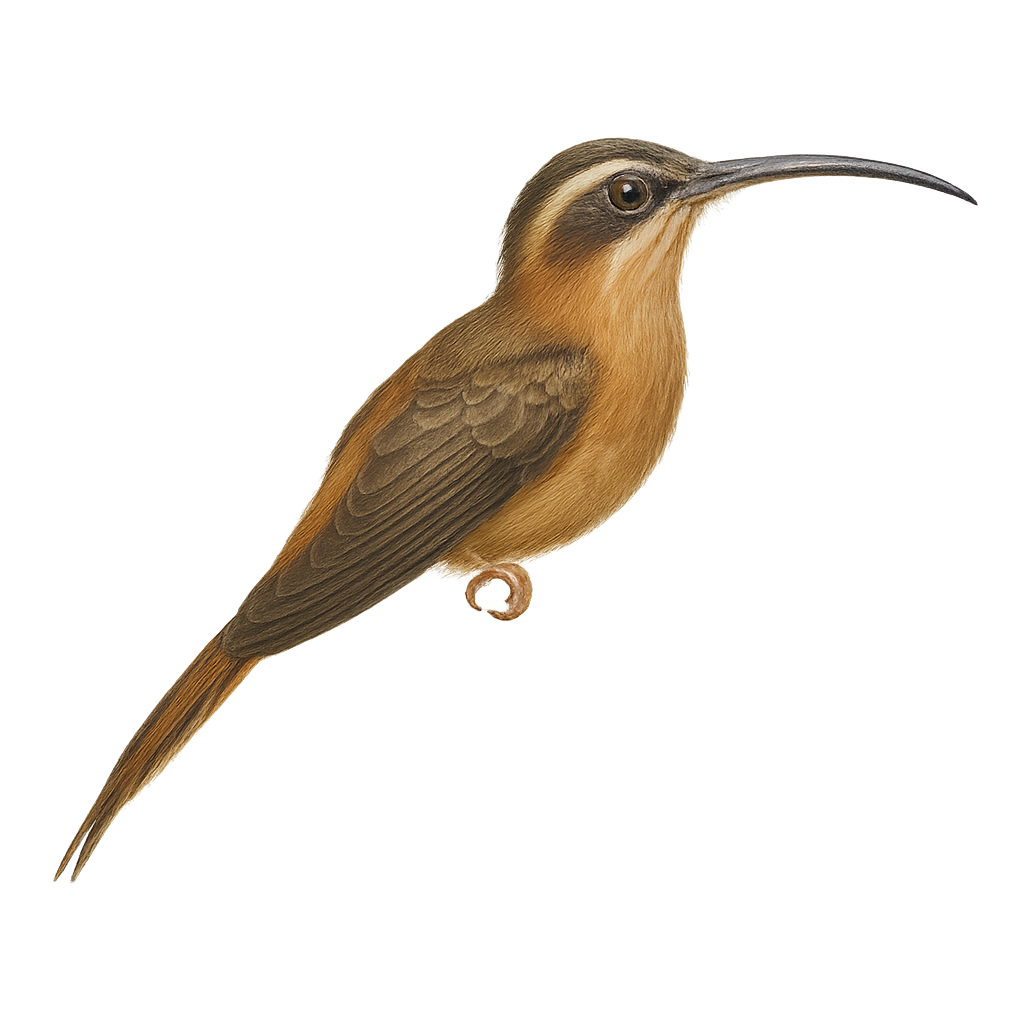The Forest Elephant is a large land mammal, characterized by its smaller size compared to the Asian Elephant and the African Savannah Elephant, standing around 2 to 3 meters at the withers and weighing between 2,000 and 5,000 kg. Its coat is gray, but its skin is often rougher than other elephants, and its ears are smaller, adapted to its forest habitat. The Forest Elephant primarily inhabits the dense forests of Central and West Africa, where it feeds on a wide variety of vegetation, including leaves, bark, fruits, and roots. Unlike the Savannah Elephant, it is more discreet and less social, though it may form small family groups. This elephant plays a key role in its ecosystem, contributing to seed dispersal and forest regeneration. However, the species is threatened by deforestation, poaching for its valuable tusks, and conflicts with human communities. It is currently listed as vulnerable by the International Union for Conservation of Nature (IUCN).
The northern elephant seal is a large marine pinniped, with adult males measuring 3–4 m in length and weighing 1800–2500 kg, and females reaching 2–2.5 m for 400–900 kg. It inhabits sandy beaches and coastal islands of the North Pacific, alternating long foraging trips at sea feeding on squid and fish with land phases at breeding sites. During the breeding season (December to January), males establish harems, produce deep bellows and engage in spectacular fights for female access, while females dig shallow nests and give birth to a single pup.
Large marine mammal in the family Phocidae, reaching up to 3.5 m in length and 600 kg in weight. It inhabits Antarctic and subantarctic coastal waters, feeding mainly on fish, cephalopods and juvenile seals. During the breeding season, females give birth to a single pup on the ice or beach and nurse it for about three weeks.
The Glittering-bellied Emerald, or Chlorostilbon lucidus, is a small hummingbird with dazzling, predominantly green plumage with metallic sheen. This winged jewel is endemic to the subtropical and tropical regions of South America, particularly in Argentina, Brazil, and Uruguay. It inhabits open forests, savannas, and urban gardens, where it primarily feeds on nectar, playing a crucial role in plant pollination. Its rapid and agile flight allows it to move easily between flowers. Despite its small size, it is territorial and does not hesitate to chase intruders from its feeding area. Its breeding period varies by region, but it is generally active year-round.
Emu
Dromaius novaehollandiae
The Emu is a large flightless bird, belonging to the ratite family, which also includes the ostrich and the kiwi. It typically stands between 1.5 and 1.9 meters tall and weighs between 40 and 60 kg. Its plumage is generally brown-gray, with fine feathers that give it a slightly ruffled appearance. The Emu is recognizable by its long bare neck and small wings, which prevent it from flying. It is endemic to Australia, where it inhabits a variety of environments, from open forests to savannas and semi-desert areas. This bird is primarily herbivorous, feeding on seeds, fruits, roots, and young shoots. Although it cannot fly, the Emu is a fast runner, capable of reaching speeds up to 50 km/h over short distances. It is often solitary or lives in small groups, except during the breeding season. The Emu plays an important role in seed dispersal, contributing to the regeneration of vegetation. While the species is currently listed as of least concern, it faces threats such as habitat loss, hunting, and collisions with vehicles.
The Red-necked Nightjar is a fascinating nocturnal bird, primarily found in southern Europe and northern Africa. It is distinguished by its mottled brown plumage, which allows it to blend perfectly into its environment. Its rufous throat and long tail are characteristic features. This master of camouflage is often difficult to spot during the day, as it rests motionless on the ground or on low branches. It is most active at dusk and night, feeding mainly on insects caught in flight with its wide beak. Its soft, repetitive song is often heard during summer nights. Although its habitat is threatened by urbanization and intensive agriculture, it remains relatively common in some areas.
The Eastern Whip-poor-will, or Antrostomus vociferus, is a medium-sized nocturnal bird known for its distinctive call that echoes through the forests of eastern North America. Its cryptic plumage, a blend of gray, brown, and black, allows it to blend seamlessly into its forest environment. It is primarily active at dusk and dawn, feeding on flying insects it catches in flight. This bird nests on the ground, often on a bed of dead leaves, and does not build an elaborate nest. Its breeding season extends from spring to summer, and it is known for its fidelity to its nesting sites. Although discreet, its repetitive and melodious call is a characteristic feature of summer evenings in its natural habitat.
The Common Nighthawk, Chordeiles minor, is a fascinating bird belonging to the Caprimulgidae family. This small migratory bird is known for its crepuscular and nocturnal habits, primarily feeding on flying insects caught in flight. Its cryptic plumage, consisting of brown, gray, and white hues, allows it to blend effectively into its surroundings. It is primarily found in open areas such as grasslands, agricultural fields, and urban zones. During the breeding season, it performs impressive aerial displays to attract females. Although its song is discreet, it is often heard at dusk and dawn.
The European Nightjar is a nocturnal bird, often difficult to spot due to its perfectly camouflaged plumage that helps it blend into its surroundings. It measures about 23 to 26 cm in length, with a wingspan of 50 to 55 cm. Its plumage is primarily brown, with complex patterns of spots and streaks that perfectly mimic the colors and textures of forest floors or dry meadows. The European Nightjar primarily feeds on nocturnal insects, which it captures in flight with its wide mouth open. It hunts at dusk and during the night, using its broad, rounded wings to maneuver silently through the air. This bird is often seen flying in circles or zigzags above fields, forests, or open areas. During the breeding season, the female lays its eggs directly on the ground, often in well-hidden spots. While the species is not currently endangered, it faces threats such as habitat loss, light pollution, and the decline of nocturnal insects.
The Chuck-will's-widow, or Antrostomus carolinensis, is a fascinating nocturnal bird known for its distinctive call that echoes through the forests of the southeastern United States. It features cryptic brown and gray plumage, perfect for blending into fallen leaves. This bird measures about 28 to 33 cm in length with a wingspan of 58 to 62 cm. It is primarily insectivorous, feeding on moths, beetles, and other flying insects caught in flight. The Chuck-will's-widow nests directly on the ground, often among leaves, without building a nest. Its breeding season extends from spring to summer, and it is known for its discreet behavior and ability to remain still for long periods to avoid predators.
The Indian Nightjar is a fascinating bird, primarily nocturnal, known for its cryptic plumage that allows it to blend seamlessly into its surroundings. It is often seen in open forests, clearings, and shrublands. Its song, a soft and repetitive trill, often resonates at dusk and dawn. This bird primarily feeds on insects, which it catches in flight with its wide beak and sensitive bristles. Although discreet, it plays a crucial role in ecosystem balance by regulating insect populations. Its breeding season varies by region, but it is generally monogamous and lays eggs directly on the ground without building a nest.
The Ridgway's Whip-poor-will is a discreet and mysterious bird, known for its cryptic plumage that allows it to blend seamlessly into its surroundings. Primarily nocturnal, it is often heard rather than seen, emitting melodious calls at dusk. It inhabits dry forests and open wooded areas, feeding mainly on flying insects caught in flight. Its ability to remain motionless for extended periods makes it difficult to spot. Although relatively tolerant of human presence, it prefers quiet, undisturbed habitats. Its breeding season coincides with the abundance of insects, ensuring ample food for its young.
The Lesser Nighthawk, Chordeiles acutipennis, is a nocturnal bird belonging to the Caprimulgidae family. It is primarily found in arid and semi-arid regions of the Americas, from the southern United States to Argentina. This bird is recognizable by its cryptic brown-gray plumage, which allows it to blend into its surroundings, and its long pointed wings. It feeds mainly on insects caught in flight with its wide mouth. During the breeding season, the male performs aerial displays to attract a mate. Nests are often simple ground depressions where the female typically lays two eggs. The species is considered of least concern by the IUCN, although some populations may be affected by habitat loss.
The Grey Peacock-Pheasant, or Polyplectron bicalcaratum, is a captivating bird from the Phasianidae family, native to the dense forests of Southeast Asia. It is recognizable by its grey plumage adorned with eye-like patterns, giving it a majestic appearance. Males display long tail feathers during courtship to attract females. This bird prefers forest habitats where it feeds on seeds, insects, and small invertebrates. Although discreet, it is sometimes seen in small family groups. Its ability to blend into dense vegetation makes it difficult to spot, but its melodious call often reveals its presence.
The Mountain Peacock-Pheasant, or Polyplectron inopinatum, is a fascinating bird native to the mountainous forests of Malaysia. This medium-sized pheasant is notable for its brown plumage adorned with iridescent ocelli patterns, giving it a majestic appearance. Males display a long tail which they fan out during courtship displays to attract females. These birds are generally solitary or live in small family groups. Their diet mainly consists of insects, small invertebrates, and seeds. Although their habitat is threatened by deforestation, they are still found in several nature reserves. Their discreet behavior and ability to blend into their environment make them challenging yet rewarding to observe for bird enthusiasts.
The Sharp-shinned Hawk, a small raptor from the Accipitridae family, is an agile and swift hunter often seen in the dense forests of North America. It is characterized by its modest size, short rounded wings, and long barred tail. Its plumage is typically blue-gray above and rufous-streaked below. This predator primarily feeds on small birds, capturing them in flight with its acrobatic flying skills. Although discreet, it is sometimes spotted during its seasonal migrations. The Sharp-shinned Hawk plays a crucial role in controlling smaller bird populations, thus contributing to the ecological balance of its habitat.
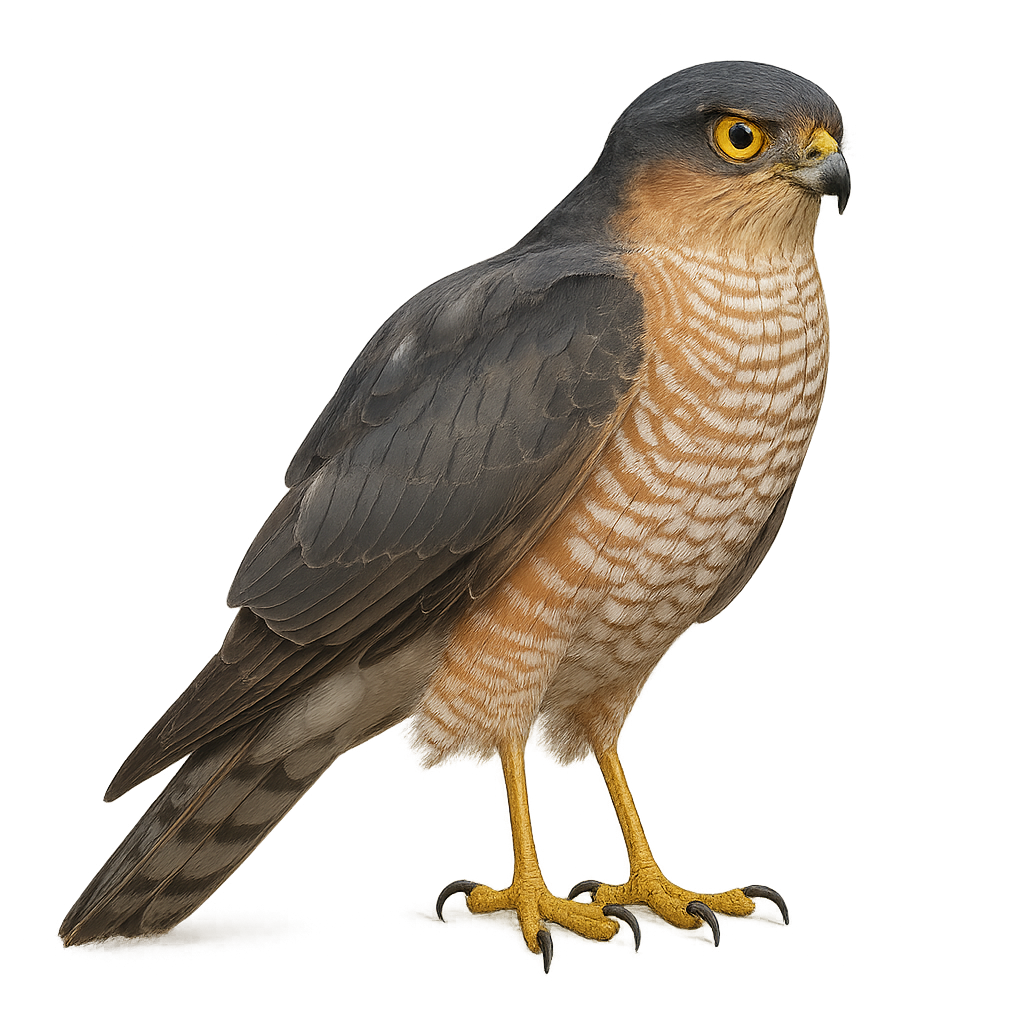
The European Sparrowhawk is a small raptor from the Accipitridae family, easily recognizable by its gray-brown plumage and narrow wings adapted for hunting in forests. It measures about 30 to 40 cm in length, with a wingspan of 60 to 90 cm, and weighs between 150 and 250 g. The male is generally smaller than the female. Its plumage varies depending on sex and age, but adults have bluish-gray feathers on the back and brownish horizontal bars on the belly. The European Sparrowhawk primarily inhabits dense forests and wooded areas in Europe, but it can also be found in urban parks and gardens. This raptor is an excellent hunter, primarily feeding on smaller birds, which it captures in flight after a rapid pursuit through trees. It often hunts using a silent, swift flight technique and is capable of capturing prey in confined spaces. Although the European Sparrowhawk is currently listed as of least concern, it faces threats such as habitat loss, disturbance of its nesting sites, and persecution by humans.
The Cooper's Hawk is a medium-sized raptor known for its sleek body and rounded wings. Its plumage is mostly bluish-gray on the back with reddish barring on the underparts. Adults have striking red eyes, while juveniles have yellow eyes. This agile predator is often seen flying through dense forests or hunting in urban areas. It primarily feeds on birds and small mammals. Its adaptability to various environments makes it a resilient bird, although habitat destruction poses a potential threat.
The Frances's Sparrowhawk, or Accipiter francesiae, is a small raptor endemic to Madagascar. This agile predator is recognizable by its slender silhouette and short, rounded wings, ideal for maneuvering through dense forests. Its plumage is generally gray on top and white with brown streaks underneath, allowing it to blend into its environment. It primarily feeds on small birds, insects, and occasionally small mammals. The Frances's Sparrowhawk is a discreet bird, often difficult to observe due to its shy behavior. It plays a crucial role in controlling the populations of its prey, thus contributing to the ecological balance of its habitat.
The Crimson Chat is a small bird primarily found in Australia, easily identifiable by its striking plumage of red, black, and white hues. Males display a vivid red on their chest and forehead, while females are duller, with brownish tones. This bird is often seen in arid and semi-arid regions, feeding mainly on insects and nectar. Known for its adaptability to harsh environments, the Crimson Chat is a resilient species. It typically builds its nest in low shrubs, using materials like twigs and grasses.
The Buff-tailed Coronet, or Haplophaedia assimilis, is a fascinating small hummingbird known for its striking plumage and distinctive tail. This bird features predominantly green plumage with metallic sheens, while its tail is relatively long and slender, giving it its name. It is mainly found in the humid forests of the Andes, where it feeds on nectar and plays a crucial role in pollinating local plants. Its fast and agile flight allows it to move easily between flowers. Although discreet, it is often observed defending its territory against other hummingbirds. The Buff-tailed Coronet is a perfect example of hummingbird adaptation to mountainous environments.
The Black-breasted Puffleg, or Eriocnemis nigrivestis, is a hummingbird endemic to the Ecuadorian Andes. This small bird is particularly recognizable by its black crest and white feather tufts on its legs, which give it its name. Males display a shiny black plumage with bluish hues, while females are duller with greenish tones. This hummingbird primarily inhabits cloud forests and shrublands at high altitudes. Unfortunately, it is considered critically endangered due to deforestation and habitat loss. Conservation efforts are crucial to ensure its survival.
The Coppery-bellied Puffleg, Eriocnemis cupreoventris, is a small, captivating bird endemic to the Andes in Colombia and Venezuela. This hummingbird is distinguished by its striking plumage, with a coppery belly that shimmers in sunlight. Males display metallic sheens on their backs and heads, while females have more subdued tones. Measuring about 10 cm in length, this bird is an essential pollinator in its natural habitat. It primarily inhabits cloud forests and shrublands at high altitudes. Its fast and agile flight allows it to feed on the nectar of tubular flowers, playing a crucial role in pollination.
The Buff-tailed Coronet, Eriocnemis vestita, is a fascinating bird from the Trochilidae family. This small hummingbird is recognizable by its fluffy white feathered legs, contrasting with its metallic green plumage. It primarily inhabits cloud forests and mountainous areas of the Andes, where it feeds on nectar and insects. Its fast and agile flight allows it to easily navigate between flowers. Although its habitat is relatively stable, it is sensitive to environmental disturbances. Males and females are similar in appearance, although males may be slightly more colorful. This hummingbird plays an essential role in pollinating the plants in its habitat.
The Musk Duck, Biziura lobata, is a diving duck native to Australia, known for its broad bill and stiff tail. Males display a lobed flap under the bill during courtship displays. This duck prefers large freshwater bodies like lakes and swamps, feeding mainly on mollusks, crustaceans, and aquatic insects. Although often solitary, it can be seen in small groups. Its ability to dive deeply and stay underwater for extended periods makes it an effective hunter. The species is currently classified as Least Concern by the IUCN but is sensitive to environmental changes and habitat degradation.
The white-headed duck is a small diving duck, 40–45 cm long, with males displaying a white head, slate-grey body and bright blue bill, while females have a brownish head and darker bill. It inhabits freshwater lakes and ponds fringed by dense emergent vegetation, diving to feed mainly on aquatic plants and small invertebrates. Shy and solitary, it typically swims away under water when threatened rather than flying.
The Ruddy Duck is a small diving duck with distinctive plumage. The male has a black head with a bright blue bill, a reddish-brown body, and often holds its tail upright. The female is more subdued, with brown plumage and subtler facial patterns. These ducks are commonly found in North American wetlands but have also been introduced to Europe. They prefer calm waters rich in vegetation, feeding mainly on aquatic plants, insects, and small crustaceans. Their behavior is generally not very shy, making them accessible for observation. They are known for their spectacular courtship displays, where the male shows off his blue bill and upright tail to attract the female.
The Masked Duck is a small diving duck known for its unique plumage and elusive behavior. Males display a striking rufous plumage with a black head and a distinctive white mask, while females and juveniles are duller with brownish patterns. This species prefers dense aquatic habitats such as marshes and ponds with abundant vegetation. It is primarily nocturnal, feeding on aquatic plants, insects, and small invertebrates. Although widely distributed in the Caribbean and parts of Central and South America, it remains difficult to spot due to its shy nature and habit of hiding in dense vegetation.
The Long-tailed Hermit, or Phaethornis superciliosus, is a fascinating hummingbird found mainly in the tropical forests of South America. This small bird is recognizable by its long, curved bill, perfect for extracting nectar from tubular flowers. Its plumage is primarily brown with greenish hues and a distinctive stripe above the eye, giving it the name "superciliosus". It is often seen darting from flower to flower, playing a crucial role in pollination. Although generally solitary, it can sometimes be observed in small groups during the breeding season. Its ability to adapt to various habitats, including forest edges and gardens, makes it a resilient bird despite environmental threats.
The Stripe-throated Hermit, or Phaethornis striigularis, is a small hummingbird native to the tropical rainforests of Central and South America. This tiny bird, measuring about 10 to 12 cm in length, is recognizable by its brown-green plumage and white-striped throat. It has a long, curved bill, perfect for feeding on the nectar of tubular flowers. Males and females look similar, although males often have slightly brighter colors. The Stripe-throated Hermit is a solitary bird, often seen darting quickly from flower to flower. It plays a crucial role in the pollination of tropical plants.



